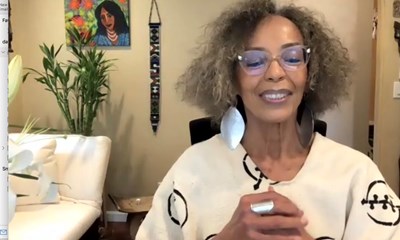Jack Oehm Recounts Events of the Day and Recovery Efforts
 Image by Tory Wesnofske
Image by Tory Wesnofske
09/17/2021
By Katharine Webster
Sept. 11. Four planes. 2,996 people from 90 countries killed. More than 6,000 injured.
Twenty years later, retired New York City Fire Department Battalion Cmdr. Jack Oehm used dates and staggering numbers to recount the history of the Sept. 11, 2001, terrorist attacks, speaking at a recent campus event.
“I lost 20 of my men that day,” Oehm told an audience that included Lowell police and firefighters, UMass Lowell police, ROTC officers, faculty and students. “Three of nine units never came home.”
“We study history to learn from our mistakes.”
Oehm, cofounder of the Tunnel to Towers Foundation, which helps the families of first responders and disabled veterans, held the audience spellbound with a history lesson that he lived. He urged students to study the attacks, which happened before many of them were born.
“Why do we study history?” he asked. “We study history to learn from our mistakes.”
 Image by Tory Wesnofski
Image by Tory Wesnofski
The event was sponsored by UML's Office of Community Relations and organized by Political Science Prof. Jeffrey Gerson for his Introduction to American Politics class. Students in an Introduction to American History class and a First-year Seminar in Honors section also attended. Gerson organizes an educational event related to the attacks nearly every year.
Gerson incorporated the Sept. 11 attacks into his course out of respect for Carie Lemack, whose mother died that day: She later asked UMass Lowell to create a 9/11 curriculum.
Because high school history books do not yet include the attacks, Gerson said it's often the first time his students have a chance to consider the events leading up to that day and the aftermath, and they find it very valuable.
"After we take a closer look at post-9/11 America - this week, we'll Zoom with three experts on Afghanistan to talk about America's involvement there - they begin to understand how profoundly America was changed," he said.
Oehm's talk was right on point. He quizzed the students about important dates in the lead-up to the attacks: Aug. 2, 1990, when Iraq invaded Kuwait, leading to a U.S.-led military intervention, Operation Desert Storm. Feb. 26, 1993, when terrorists linked to Sheikh Omar Abdel-Rahman carried out the first World Trade Center bombing, detonating a van full of explosives in a parking garage under the North Tower. Six people died; more than 1,000 were injured.
 Image by Tory Wesnofske
Image by Tory Wesnofske
Afterward, despite warnings from Abdel-Rahman that “We’ll be back to get the towers,” Oehm said, the U.S. government failed to prevent the Sept. 11, 2001, attacks.
More numbers: Jet fuel burns at 1,500 degrees. Among the 412 emergency workers who died at the World Trade Center, 343 were New York City firefighters. The towers collapsed in 11 seconds each, one at 9:59 a.m. and the other four minutes later, leaving a debris pile more than six stories above ground and another eight stories below, spread over 16 acres. Building 7 collapsed later in the day.
Off duty when the attacks occurred, Oehm rushed back to work after the twin towers collapsed. He climbed to the top of the debris pile and worked alongside firefighters from all over the city who hoped to rescue people, he said. First responders from around the country soon joined them.
 Image by Tory Wesnofske
Image by Tory Wesnofske
New York City firefighters, along with construction workers and volunteers, spent eight months working through the debris pile, trying to recover even the smallest traces of the deceased so that families could lay their loved ones to rest. All the remains that they found were labeled with precise GPS locations. Forty percent of those who died left no discernible trace.
The Tunnel to Towers Foundation, started by the family of firefighter Stephen Siller, who ran through the Brooklyn Battery Tunnel carrying 60 pounds of equipment to help save lives on Sept. 11, only to lose his own, has raised $250 million, according to its website.
When a firefighter or first responder dies on duty, leaving a family with young children, the foundation pays off the family’s mortgage in honor of Siller, a 34-year-old who left a widow and five young children. Tunnel to Towers has also built nearly 100 “smart homes” for severely disabled military veterans, Oehm said.
 Image by K. Webster
Image by K. Webster
English major Catherine Poirier, a senior from Methuen, Massachusetts, called the event “very informative.”
“I feel like I’ve learned about 9/11 every year since I was in high school, but it was always the same information, repeated,” she said. “He talked about aspects of it I never learned about before, like how long it took to recover everyone, and the process.”
Gabriel Guimaraes, a first-year honors student majoring in political science who immigrated from Brazil two years ago, said he had never heard about the attacks from someone living in the U.S. when they happened.
Before listening to Oehm, he only knew about the World Trade Center attacks, not the plane that flew into the Pentagon or the one that crashed in Shanksville, Pennsylvania, after passengers stormed the cabin, preventing an attack on the Capitol.
That changed his view of history, Guimaraes said.
“I used to think it was a symbolic attack, because the World Trade Center represented economic prosperity and the development of technology,” he said. “Now I know about the planes that were going to Washington, I think it was an attack on democracy itself.”




